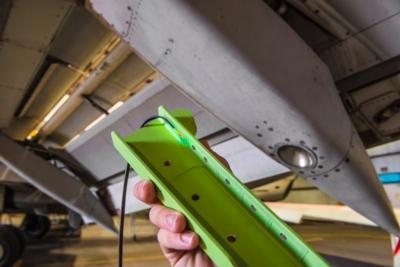Sandia Labs Testing Advanced Technology To Enhance Aviation Safety
Nine commercial aircraft flying regular routes are on the frontier of aviation safety, carrying sensors that monitor their structural health along with their routine maintenance. These flight tests are part of an FAA certification process that will make the sensors widely available to U.S. airlines.

“The flight test program is underway,” said Dennis Roach, a senior scientist in Sandia National Laboratories’ Transportation, Safeguards & Surety Program who has worked in aviation safety for 25 years. “We have moved past laboratory research and are looking for certification for actual on-board usage. Our activities are proving that the sensors work on particular applications and that it is safe and reliable to use these sensor systems for routine aircraft maintenance.”
Delta Air Lines Inc. and a foreign aircraft manufacturer have partnered with Sandia researchers in two separate programs to install about 100 sensors on their commercial aircraft. These teams worked together to provide the installation procedures for technicians and now oversee monitoring of the in-flight tests.
The flight tests complement laboratory performance testing at Sandia to provide the critical step in a decade-long journey to enhance airline safety through a more comprehensive program of Structural Health Monitoring. SHM uses nondestructive inspection principles — technologies that examine materials for damage without affecting their usefulness — and built-in sensors that automatically and remotely assess an aircraft’s structural condition in real time and signal the need for maintenance.

Roach said the goal of monitoring the sensors installed on the aircraft is to accumulate successful flight history to show that the sensors can sustain the operating environment, while providing the proper signals for flaw detection.
SHM eventually could help airlines save money by basing maintenance on the actual condition of the aircraft, rather than fixed schedules and inspection routines that might not be necessary, and thereby reduce airplanes’ downtimes, Roach said.
The team said so far, sensors installed on the aircraft are working as expected.
Next year, Sandia intends to present the flight and laboratory test results to the FAA for approval and certification. Should the FAA approve the sensors, they would be available for specific applications across the entire airline industry and the process for certifying future applications should be more efficient because of the research being conducted now.
(Pictured Top: Sandia National Laboratories senior scientist Dennis Roach, center, works inside the cabin of a B737 test bed, installing and acquiring data from Structural Health Monitoring sensors with Sandia mechanical engineers Stephen Neidigk and Tom Rice. Bottom: Structural Health Monitoring sensors are custom built to fit an aircraft’s parts. They can be mounted in hard-to-reach areas of an aircraft so that mechanics can plug in to acquire data without the time, cost and risk of removing parts from the aircraft)
 ANN's Daily Aero-Term (04.28.24): Airport Marking Aids
ANN's Daily Aero-Term (04.28.24): Airport Marking Aids Aero-News: Quote of the Day (04.28.24)
Aero-News: Quote of the Day (04.28.24) ANN's Daily Aero-Linx (04.28.24)
ANN's Daily Aero-Linx (04.28.24) Aero-News: Quote of the Day (04.29.24)
Aero-News: Quote of the Day (04.29.24) ANN's Daily Aero-Linx (04.29.24)
ANN's Daily Aero-Linx (04.29.24)




